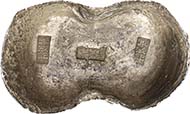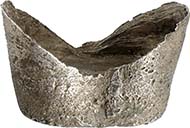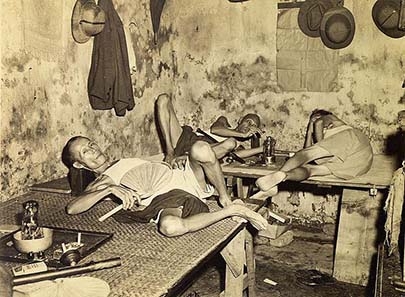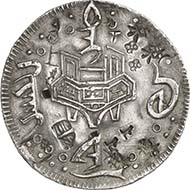In Chinese millenniums old history the monetary system developed in an entirely different way than the one in Europe. Until recently, the coins of the West – at least the ones that weren’t used as change – were small ingots of precious metal whose intrinsic value was directly linked to their nominal value. The Chinese copper coins and China’s famous paper money, by contrast, were fiat money, just like our present-day currency. That means that their value was based on a mutual agreement concerning the copper coins and on a imperial warranty concerning the paper money.
Traditional silver ingot of 50 tael, produced in the Shantung Province at the end of the 19th / beginning of the 20th centuries. From auction Künker 198 (September 30, 2011), no. 9307.
Apart from these two kinds of currency, for hoarding of money particularly, silver ingots were used which were produced by private craftsmen. The state only controlled the correct marking with fineness and weight. That was in its own interest since silver ingots, apart from textiles and grain, served to settle up the taxes. The Chinese monetary system of early modern times, therefore, was much more similar to our own than contemporary Western coinages.
Spanish 8 reales piece from the 17th cent. From auction Künker 165 (March 8, 2010), 1115.
When the first Western coins reached China, they were treated like bullion. The local money-changer checked their fineness, provided them with a countermark and therewith guaranteed the quality of the coins. It is highly likely that they were melted down to ingots at the beginning, but that changed in time, the more coins arrived in China. Instead of being melted down, they were used as small ingots in payment transactions. Especially popular were the Spanish 8 reales pieces because their average fineness of 935/1000 was almost equivalent to the Chinese standard of 937/1000. They were called shizi qian, coins with the mark 10, for Chinese users read the cross depicted on them as the number ten (shi). Countless countermarks on many a piece testify to the frequency some money-changer have checked them during their circulation.
By the way, on Formosa, present-day Taiwan, these pieces circulated as early as the 17th century! Formosa was an island off the Chinese shore with a number of important ports where foreign ships anchored.
Opium den in Chinatown / Kolkata. Photo taken in 1945. Source: Wikipedia.
Hence, the Chinese travelling traders possessed a century old tradition in dealing with Western money whereas the ruling Qing Dynasty was highly skeptical towards this economical development. This was no surprise, since the foreign visitors had brought China nothing good. Mainly the British opium worried the government. The English had hit on the ‘ingenious’ idea to not exchange the treasured tea and the expensive luxury goods for silver anymore but for cheap opium they gained from Bengal, which was controlled by the East India Company. That turned the trade balance to China’s disadvantage and caused an economic realignment that was to turn one of the world’s technologically leading nations into a developing country.
The Chinese population had gotten used to the foreign silver coins, especially in the commercial centers. Now, however, they didn’t flow into the coffer like they used to do. On the contrary, silver emptied out to acquire opium. All that was left was a vacuum of currency the central government refused to fill. Private enterprises filled in.
This rare dollar will be auctioned off under lot no. 9187 in Künker sale 198 on September 30, 2011. It is but one of the many highlights of a comprehensive collection of Chinese coins offers. Its estimate amounts to 4,000 Euros.
Our piece, which will be offered on September 30, 2011 by the Osnabruck auction house and coin dealer Künker as part of a big collection of Chinese coins, belongs to this context. It is the first Western style coin struck in China. It was produced during the Rebellion of Zhang When in 1837 to pay the troops appointed with the suppression of the revolt. On Formosa, revolutions were rather normality. A common saying was: “Every three years an uprising, every five years a rebellion.”
On the coin’s obverse we see Shou Xing, God of Longevity. His distinctive feature is the outsized bald head. To the left there are four characters whose translation reads “Cast during the time of Daoguang”. Emperor Daoguang (=Splendor of Reason) ruled from October 3, 1820, until his death on February 25, 1850. Four other characters in the field to the right are translated “7, 2 by the balances of the treasure chamber”. In the god’s chest likewise four characters are to be found, which mean “silver cake of standard fineness”.
Liu ding, late Shang Dynasty. Shanghai Museum. Photograph: Mountain / Wikipedia.
The reverse depicts a “ding”, a traditional bronze vessel with, in this case, three legs and two handles. Such vessels were in use in China as early as the 16th century B. C. Prior to that time, similar vessel had been made from clay. Just like the Greek tripods, a ding was used in China to cook and to store supplies.
Another aspect was of a ritual nature: the cultic meals for the ancestors were prepared in a ding. The “ding” soon became synonymous for power and command over a country. It became a symbol for state power so much that in Chinese language “the desire for a ding” is used interchangeably for making a bid for power. The four characters on the reverse refer to the island of Formosa, the city of Kyahi in the South-East of Taiwan and the word “treasury”.
What started on Taiwan became established in Mainland China in the middle of the 19th century as well. Soon private entrepreneurs produced Western silver coins, which deviated from the European models to a greater or lesser extent. Consequently, an English writer stated in 1844: “In the district of Shunteh, south of Canton, there is said to be a very large establishment, in which as many as a hundred workmen are frequently employed. (In China were hired per day, author’s note). Dollars are there manufactured of all grades of value… These false coiners are said to possess European stamps, procured at great expense, but sometimes they attempt imitations, in which the omission or disfiguring of some letters betrays the deception to a European eye. So common, however, are their dollars in circulation, that men from this district are most usually selected as shroffs (= money-changers).”
Hence, in China silver coins following the Western model were produced long before the Chinese government, upon British recommendation, decided on establishing a mint in Canton. (For which the required machines were ordered in English Birmingham, of course.) It was in 1889 that the first official coins of the Chinese government were issued.
If you like to know more about this coin and the big collection of Chinese coins please order the complimentary catalog of the upcoming Künker sale at +49 (0)541 96 20 20 (telephone international). You will find it on the Internet as well at www.künker.de about five weeks prior to the auction date.










